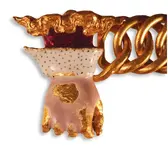What a ridiculous statement. The pendant was found at elbow-depth in an open field that has not yielded any other artefacts of this significance and was not recognised as a potentially fruitful site (by anyone). It was a chance find by a detectorist only 6 months into the hobby. Not a humiliation for archaeologists at all.
The whole purpose of our Portable Antiquities Scheme (PAS) is to encourage detectorists (via legislation including the “Treasure Act”) to report their finds such that maximum historical knowledge can be gained and important pieces are preserved for the nation such that all can view them (for free, since museums housing national collections do not charge admission fees). The Treasure Act also provides for rewards to be paid in the event that the museum services wish to acquire items on behalf of the nation.
The PAS very much recognises the contributions made by the detectorist community but what is demonised (with full support from the law) is illegal hunting without landowner permission and the concealment of important finds for illicit personal gain. In effect, a distinction between “detectorist” and “treasure hunter”.
It is wonderful to see archaeology and metal-detecting across the country thriving – helping to uncover treasures which deepen our understanding of our shared national history. Supported by the success of the Treasure Act, it means that hundreds of wonderful discoveries are now in museums across the UK where they can be enjoyed by everyone. [Lord Parkinson of Whitley Bay - Arts & Heritage Minister]
The finds recorded by the Portable Antiquities Scheme have been found by everyday people (not archaeologists), mostly by those enjoying their hobby of metal-detecting. These finds, if recorded, are making a massive contribution to archaeology and (as in the case of the Henry and Katherine pendant) helping to transform our knowledge of Britain’s past. [Michael Lewis - Head of PAS and Treasure at The British Museum]
The pendant has not yet been assessed by the Treasure Valuation Committee, but Mr Clarke is certainly due to receive a sizeable reward, which he has already agreed to split with the landowner.
The pendant has been assessed as having clear symbolism for Henry VIII and Catherine of Aragon (who used the pomegranate bush as an emblem). They married in 1509, separated in 1531, and the marriage was annulled in 1533, but Catherine lived on until 1536. Rumours that she had been poisoned were fuelled by the discovery of a black growth on her heart when she was embalmed but modern medical experts are in general agreement that the heart discolouration was due to cancer, which was not understood at the time.
Detailed analysis of the iconography and historical records suggest that the pendant may have been commissioned to be worn or given as a prize at one of the major tournaments of which Henry was so fond, around the time of the famous “Field of the Cloth of Gold” in 1520. The workmanship suggests it was hastily made. Its size suggests it would only have fitted a woman and may not have been meant to be worn at all… certainly not by either Henry or Catherine.
Helpfully, the decoration for the pendant includes a black enamel, the ‘recipe’ for which changed in the 1520s and 1530s. Analysis of the enamel has established it to be the earlier version.
For sure the kind of analyses conducted by the museum services would not have been possible if the find had been concealed or sold on the black market.
The symbolism of the white glove (emerging from a cloud) that forms the clasp hints at a possible link to the imagery used at the “Shrovetide Jousts” in 1521, which the BM regards as the probable date for the pendant.
View attachment 2079783
[Image Copyright: Birmingham Museums Trust]
 Now, you know why archaeologists are always trying to discredit and demonize treasure hunters. We've proven that we're much better at finding treasure and recovering history than they are!
Now, you know why archaeologists are always trying to discredit and demonize treasure hunters. We've proven that we're much better at finding treasure and recovering history than they are!




